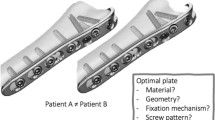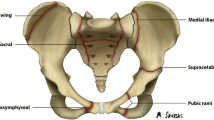Abstract
Introduction
Clinical and radiographic examinations detect delayed or nonunion only after the event has occurred. Biochemical markers of bone turnover (BTMs) are promising laboratory tools that offer an early insight into the likelihood of delayed union. We hypothesized that BTMs display temporal variations following fractures and the behavior of BTMs differ between normal and delayed union of fractures.
Methods
This was a prospective study of patients with closed fracture of tibia treated with intramedullary, interlocking nailing. BTM assays (NTX, BSAP, P1NP and osteocalcin) and clinical and radiographic assessments were obtained preoperatively and postoperatively at 8,12, 24, 36 and 72 weeks. Temporal trend of elevation of serum levels of BTMs post-fracture was the primary assessment criterion and radiographic and clinical assessment of fracture union were the secondary assessment criteria.
Results
The average time for fracture union was 15.24 weeks (range 15–19 weeks). The values of both bone formation and resorption markers peaked at the eighth week following the fracture. Resorption markers returned to baseline by 36 weeks. Among the formation markers, BSAP levels showed the smallest increase and returned to baseline earlier (36 weeks) than P1NP and osteocalcin (72 weeks). P1NP showed the most dramatic change, increasing to 2.5 times the mean baseline level at 8 weeks in normal union of fractures. The levels of bone formation markers (BSAP, OC, PINP) were significantly lower in patients with delayed union. There was no significant difference in the levels of the resorption marker (NTX) between normal and delayed union patients.
Conclusion
Serial monitoring of biochemical markers of bone turnover can be used as an adjunct to clinical and radiological observations to predict delayed union
Level of evidence
Level 2 (prospective observational study).




Similar content being viewed by others
References
Antonova E, Le TK, Burge R, Mershon J. (2013) Tibia shaft fractures: costly burden of nonunions. BMC Musculoskelet Disord:14(42).
Dahabreh Z, Calori GM, Kanakaris NK, Nikolaou VS, Giannoudis PV. A cost analysis of treatment of tibial fracture nonunion by bone grafting or bone morphogenetic protein-7. Int Orthop. 2009;33(5):1407–14.
Aro HT, Govender S, Patel AD, Hernigou P, Perera de Gregorio A, Popescu GI, et al. Recombinant human bone morphogenetic protein-2: a randomized trial in open tibial fractures treated with reamed nail fixation. J Bone Joint Surg Am. 2011;93(9):801–8.
Bhandari M, Guyatt GH, Swiontkowski MF, Tornetta P 3rd, Sprague S, Schemitsch EH. A lack of consensus in the assessment of fracture healing among orthopaedic surgeons. J Orthop Trauma. 2002;16(8):562–6.
Webb J, Herling G, Gardner T, Kenwright J, Simpson AHRW.. Manual assessment of fracture stiffness. Injury. 1996;27(5):319 – 20.
Davis BJ, Roberts PJ, Moorcroft CI, Brown MF, Thomas PBM, Wade RH. Reliability of radiographs in defining union of internally fixed fractures. Injury. 2004;35(6):557 – 61.
Bhattacharyya T, Bouchard KA, Phadke A, Meigs JB, Kassarjian A, Salamipour H. The accuracy of computed tomography for the diagnosis of tibial nonunion. J Bone Joint Surg Am. 2006;88(4):692–7.
Moed BR, Kim EC, van Holsbeeck M, et al. Ultrasound for the early diagnosis of tibial fracture healing after static interlocked nailing without reaming: histologic correlation using a canine model. J Orthop Trauma. 1998;12(3):200–5.
Morshed S. (2014) Current Options for Determining Fracture Union. Adv Med Volume 2014. Article ID 708574. https://doi.org/10.1155/2014/708574.
Obrant KJ, Ivaska KK, Gerdhem P, Alatalo SL, Pettersson K, Väänänen HK. Biochemical markers of bone turnover are influenced by recently sustained fracture. Bone. 2005;36(5):786–92.
Cox G, Einhorn TA, Tzioupis C, Giannoudis PV. (2010) Bone-turnover markers in fracture healing. J Bone Joint Surg Br 92:329–34.
Coulibaly MO, Sietsema DL, Burgers TA, Mason J, Williams BO, Jones CB. Recent advances in the use of serological bone formation markers to monitor callus development and fracture healing. Crit Rev Eukaryot Gene Expr. 2010;20(2):105–27.
Han B, Copeland M, Geiser AG, Hale LV, Harvey A, Ma YL, et al. Development of a highly sensitive, high-throughput, mass spectrometry-based assay for rat procollagen type-I N-terminal propeptide (PINP) to measure bone formation activity. J Proteome Res. 2007;6(11):4218–29.
Manolagas SC, Burton DW, Deftos LJ. 1,25-Dihydroxyvitamin D3 stimulates the alkaline phosphatase activity of osteoblast-like cells. J Biol Chem. 1981;256(14):7115–7.
Corrales LA, Saam M, Bhandari M, Miclau T 3rd. Variability in assessment of fracture healing in orthopedic trauma studies. J Bone Joint Surg Am. 2008;90(9):1862–8.
No author listed (1988) United States Food and Drug Administration (USFDA), Office of Device Evaluation, Guidance Document for Industry and CDRH Staff for the Preparation of Investigational Device Exemptions and Premarket Approval Application for Bone Growth Stimulator Devices. USFDA, Maryland, USA.
Harwood PJ, Newman JB, Michael ALR. An update on fracture healing and non-union. J Orthop Trauma. 2010;24(1):9–23.
Ohishi T, Takahashi M, Kushida K, Hoshino H, Tsuchikawa T, Naitoh K, Inoue T. Changes of biochemical markers during fracture healing. Arch Orthop Trauma Surg. 1998;118(3):126 – 30.
Ichimura S, Hasegawa M. Biochemical markers of bone turnover. New aspect. Changes in bone turnover markers during fracture healing. Clin Calcium. 2009;19(8):1102–8.
Southwood LL, Frisbie DD, Kawcak CE, McIllwraith CW. (2003) Evaluation of serum biochemical markers of bone metabolism for early diagnosis of nonunion and infected nonunion fractures in rabbits. Am J Vet Res 64(6): 727–35.
Emami A, Larsson A, Petrén-Mallmin M, Larsson S. Serum bone markers after intramedullary fixed tibial fractures. Clin Orthop Relat Res. 1999;368:220–9.
Mallmin H, Ljunghall S, Larsson K. (1993) Biochemical markers of bone metabolism in patients with fracture of the distal forearm. Clin Orthop Relat Res (295):259 – 63.
Stoffel K, Engler H, Kuster M, Riesen W. Changes in biochemical markers after lower limb fractures. Clin Chem. 2007;53:131–4.
Klein P, Bail HJ, Schell H, Mischel R, Amthauer H, Bragulla H, et al (2004). Are bone turnover markers capable of predicting callus consolidation during bone healing?. Calcif Tissue Int 75(1):40–9.
Seebeck P, Bail HJ, Exner C, et al. Do serological tissue turnover markers represent callus formation during fracture healing? Int J Bone Mineral Soc. 2005;37(5):669 – 77.
Joerring S, Jensen LT, Andersen GR, Jonhansen JS. Type I and III procollagen extension peptides in serum respond to fracture in human. Arch Orthop Trauma Surg. 1992;11:265–7.
Moghaddam A, Müller U, Roth HJ, Wentzensen A, Grützner PA, Zimmermann G. TRACP 5b and CTX as osteological markers of delayed fracture healing. Injury. 2011;42(8):758 – 64.
Kurdy NM. Serology of abnormal fracture healing: the role of PIIINP, PICP, and BsALP. J Orthop Trauma. 2000;14(1):48–53.
Granchi D, Gómez-Barrena E, Rojewski M, Rosset P, Layrolle P, Spazzoli B, Donati DM, Ciapetti G. Changes of bone turnover markers in long bone nonunions treated with a regenerative approach. Stem Cells Int. 2017. https://doi.org/10.1155/2017/3674045.
Ikegami S, Kamimura M, Nakagawa H, Takahara K, Hashidate H, Uchiyama S, et al. Comparison in turnover markers during early healing of neck fractures and trochanteric fractures in elderly patients. Orthop Rev (Pavia). 2009;1(21):51 – 5.
Vasikaran S, Eastell R, Bruyère O, Foldes AJ, Garnero P, Griesmacher A, McClung M, Morris HA, Silverman S, Trenti T, Wahl DA, Cooper C, Kanis JA. IOF-IFCC Bone Marker Standards Working Group. (2011) Markers of bone turnover for the prediction of fracture risk and monitoring of osteoporosis treatment: a need for international reference standards. Osteoporos Int 22(2):391–420.
Author information
Authors and Affiliations
Corresponding author
Ethics declarations
Conflict of interest
Authors have no conflicts of interests.
Rights and permissions
About this article
Cite this article
Kumar, M., Shelke, D. & Shah, S. Prognostic potential of markers of bone turnover in delayed-healing tibial diaphyseal fractures. Eur J Trauma Emerg Surg 45, 31–38 (2019). https://doi.org/10.1007/s00068-017-0879-2
Received:
Accepted:
Published:
Issue Date:
DOI: https://doi.org/10.1007/s00068-017-0879-2




